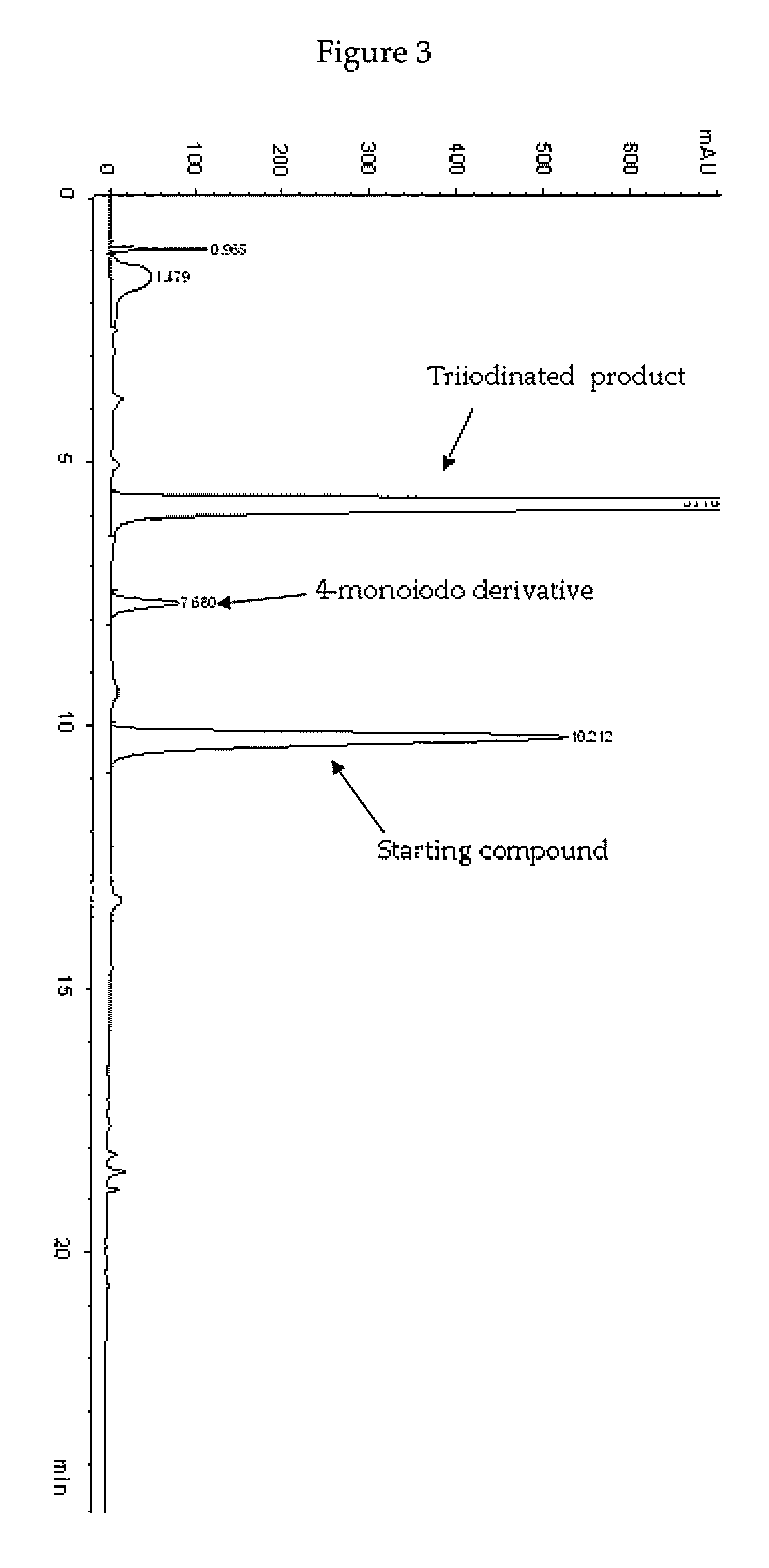Process for the iodination of phenolic derivatives
- Summary
- Abstract
- Description
- Claims
- Application Information
AI Technical Summary
Benefits of technology
Problems solved by technology
Method used
Image
Examples
example 1
Preparation of a Compound of Formula 2 Wherein R and R′ Both are a —NH—CH2—CH(OH)CH2OH Group Using a Starting Solution Heated at 60° C.
[0135]In a 2 L four-necked jacket reactor equipped with mechanical stirrer, condenser and combined pH / temperature electrode, an aqueous solution of 3,5-disubstituted phenol 1 sodium salt, corresponding to 22.8% (w / w) of phenol, (1175 g of solution; 0.816 mol; pH 9.6) was heated at 60° C. then solid I2 (250.6 g; 0.988 mol) was added in one portion. When the pH spontaneously decreased to 5, a 50% (w / w) aqueous solution of HIO3 (173.6 g; 0.494 mol) was slowly added over 2 h. The reaction mixture was maintained at 60° C. for additional 4 h in the meanwhile the pH spontaneously remained at 5-5.5. The red solution was cooled to 25° C. and quenched by addition of an 18% (w / w) aqueous solution of sodium bisulfite until decolourisation and the redox potential, measured with a suitable redox electrode, reached a stable negative value ranging from 0 to −20 mV.
[...
example 2
Preparation of a Compound of Formula 2 Wherein R and R′ Both are a —NH—CH2—CH(OH)CH2OH Group Using a Starting Solution Heated at 40° C.
[0138]In a 2 L four-necked jacket reactor equipped with mechanical stirrer, condenser and combined pH / temperature electrode, solid I2 (250.6 g; 0.988 mol) was added in one portion to an aqueous solution of 3,5-disubstituted phenol 1 sodium salt corresponding to 22.8% (w / w) of phenol (1175 g of solution; 0.816 mol; pH 9.6) heated at 40° C. When the pH spontaneously decreased to 5, a 50% (w / w) aqueous solution of HIO3 (173.6 g; 0.494 mol) was slowly added over 3 h. The reaction mixture was then heated 2 h at 40° C., 1 h at 50° C. and 1 h at 60° C. during which the pH spontaneously remained at 5-5.5. The red solution was cooled to 25° C., adjusted and maintained at pH 7 with 30% (w / w) aqueous solution of NaOH during the quenching performed by addition of an 18% (w / w) aqueous solution of sodium bisulfite until decolourisation and the redox potential, mea...
example 3
Preparation of a Compound of a Formula 2 Wherein R and R′ Both are —NH—CH2—CH(OH)CH2OH Group Using a Starting Solution Heated at 30° C. and Final Quenching with Bisulfite at pH 5
[0140]In a 4 L four-necked jacket reactor equipped with mechanical stirrer, condenser and combined pH / temperature electrode, an aqueous solution of 3,5-disubstituted phenol 1 sodium salt, corresponding to 22.8% (w / w) of phenol (1175 g of solution; 0.816 mol; pH 9.6) was diluted with H2O (1054 g), heated at 30° C., and then added with solid I2 (250.6 g; 0.988 mol) in one portion. When the pH spontaneously decreased to 5, a 50% (w / w), aqueous solution of HIO3 (173.6 g; 0.494 mol) was slowly added over 4 h. The reaction mixture was raised to 60° C. and maintained to this value for additional 4 h, in the meanwhile the pH spontaneously remained at 5-5.5. The red solution was cooled to 25° C. and quenched by addition of an 18% (w / w) aqueous solution of sodium bisulfite, maintaining pH 5 by addition of 30% (w / w) aq...
PUM
| Property | Measurement | Unit |
|---|---|---|
| molar ratio | aaaaa | aaaaa |
| molar ratio | aaaaa | aaaaa |
| molar ratio | aaaaa | aaaaa |
Abstract
Description
Claims
Application Information
 Login to View More
Login to View More - R&D
- Intellectual Property
- Life Sciences
- Materials
- Tech Scout
- Unparalleled Data Quality
- Higher Quality Content
- 60% Fewer Hallucinations
Browse by: Latest US Patents, China's latest patents, Technical Efficacy Thesaurus, Application Domain, Technology Topic, Popular Technical Reports.
© 2025 PatSnap. All rights reserved.Legal|Privacy policy|Modern Slavery Act Transparency Statement|Sitemap|About US| Contact US: help@patsnap.com



